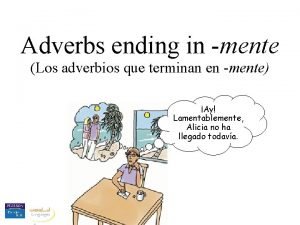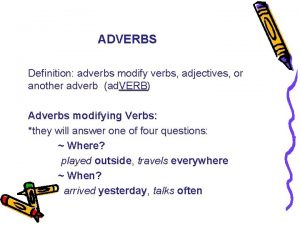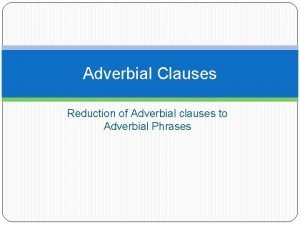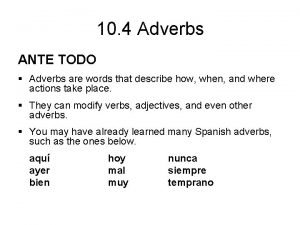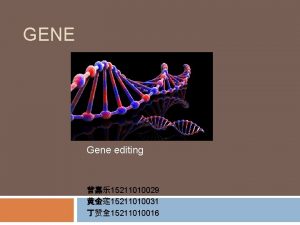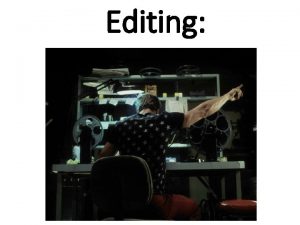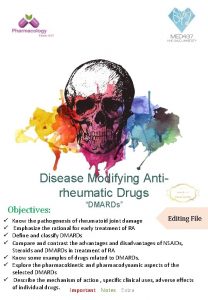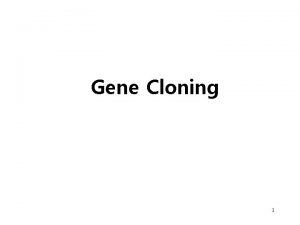Gene Editing Gene editing modifying a gene that























- Slides: 23

Gene Editing Gene editing: modifying a gene that was already there • Requires knowledge of the sequence that you wish to modify • Requires way to cut it precisely RNA interference was original approach for targeting genes • Virus defense • Can target any gene by making ds. RNA: in cell or in vitro • Way to silence gene families

Gene Editing RNA interference was original approach for targeting genes • Virus defense • Can target any gene by making ds. RNA: in cell or in vitro • Way to silence gene families • Used to create many mutants by co-suppression • Has been used to modify rice starch composition • Has been used to reduce acrylamide and browning in potato • Acrylamide by knocking down asparagine synthesis • Browning by knocking down polyphenol oxidase

Gene Editing Gene editing: modifying a gene that was already there • Requires knowledge of the sequence that you wish to modify • Requires way to cut it precisely • Four types of engineered nucleases have been developed that cut specific genomic sequences • DNA repair then creates mutations while fixing the break

Gene Editing DNA repair then creates mutations while fixing the break • Non-homologous endjoining is error-prone

Gene Editing DNA repair then creates mutations while fixing the break • Non-homologous endjoining is error-prone • Homologous DNA repair can replace DNA if a template is supplied

Gene Editing Four types of engineered nucleases have been developed that cut specific genomic sequences 1. Zn- finger nucleases came first • Fuse Zn-finger DNA binding domains with a nuclease domain • Each ~30 aa finger binds 3 bp, total monomer is ~ 300 aa • 1800 bp of cds to encode a heterodimer pair: small enough to deliver as m. RNA or in a virus

Gene Editing Four types of engineered nucleases have been developed that cut specific genomic sequences 1. Zn- finger nucleases came first 2. Meganucleases • R. E. s that bind and cut sites 12 -40 bp long • Only ~165 aa: can easily deliver • Difficult to engineer to bind new sites • Binding & cleavage sites overlap • Need to mutagenize & screen for desired specificities • Can work backwards: engineer site into transgene & use it to “stack” more transgenes at same site

Gene Editing TALENS (Transcription activator-like effector nucleases) (T • Bind activate specific plant host genes • Have 34 aa repeats that each bind a single base • Binding sites are > 30 bp! • Variable residues 12 & 13 determine specificity • Can mix and match to bind any site you want! • Can fuse DNA binding domain to many functional domains • TALENS fuse to Fok I nuclease

CRISPR/Cas 9 Overview CRISPR = Clustered Regularly Interspaced Short Palindromic Repeats • Bacterial viral defense: “remembers” foreign DNA • Inserts short fragments of target in genome • Transcribes target and g. RNA binds CAS protein • Cuts target ds. DNA @ specific sites bound by g. RNA

CRISPR/Cas 9 3 types identified Class II type 2 is simplest Transcribe trac. RNA & pre -cr. RNA then process with Rnase. III & Cas 9 Complex binds target that matches cr. RNA PAM (protospacer adjacent motif) must be 3’ to cr. RNA • Handle for Cas 9 Upon binding Cas 9 cleaves target 3 bp 5’ to PAM site

CRISPR/Cas 9 Fuse cr. RNA & tracr. RNA into a single RNA & still works • Call the cr. RNA the g. RNA • Design it to bind target sequence • Can then destroy or replace target depending on type of cut & way it is repaired

CRISPR/Cpf 1 Identified by bioinformatics DOI: http: //dx. doi. org/10. 1016/j. cell. 2015. 09. 038 • • • Only one RNA 5 nt staggered cuts Different PAM

CRISPR/Cas 9 Pro 1. Very easy (and fast) 2. Can target multiple sequences 3. High efficiency Cons: 1. PAM sequence limits potential targets 2. CAS 9 is fairly large 3. Offsite targets 4. Usually use transgenes to express g. RNA &Cas 9

CRISPR/Cas 9 Cons: 1. PAM sequence limits potential targets 2. CAS 9 is fairly large 3. Offsite targets 4. Usually use transgenes to express g. RNA &Cas 9 • Many recent studies have used RNA and protein: no DNA! • Immature wheat embryos, lettuce

CRISPR/Cas 9 Results: 1. Lots of plants have been edited to knockout genes • Increased lycopene in tomato 5 x by knocking out 5 carotenoid metabolism genes • Knocking out barley MORC 1 increased resistance to fungi • Knocking out rice Sweet 14 sugar transporter increased resistance to Xanthomonas

CRISPR/Cas 9 Results: 1. Lots of plants have been edited to knockout genes • Also used to knockout virus genes • Or host genes needed by virus • Potyviruses need host e. IF(iso)4 E

CRISPR/Cas 9 Results: 1. Lots of plants have been edited to knockout genes 2. Some have been engineered to add a superior allele • Round-up resistance in cassava • N-efficiency in rice

CRISPR/Cas 9 Results: 1. Lots of plants have been edited to knockout genes 2. Some have been engineered to add a superior allele 3. Experimentally have made synthetic transcriptional activators 4. Experimentally have made synthetic transcriptional repressors 5. Experimentally have made synthetic fluorescent reporters • Used to track DNA in living cells

CRISPR/Cas 9 Results: 1. Lots of plants have been edited to knockout genes 2. Some have been engineered to add a superior allele 3. Experimentally have made synthetic transcriptional activators 4. Experimentally have made synthetic transcriptional repressors 5. Experimentally have made synthetic fluorescent reporters • Used to track DNA in living cells • Used to track RNA in living cells

Getting rid of transgenes 1. • • Cross them out OK for getting rid of gene-editor Very tricky for getting rid of GMO

Getting rid of transgenes 1. • • 2. • Cross them out OK for getting rid of gene-editor Very tricky for getting rid of GMO Edit without a transgene Deliver DNA by transient expression (hit and run) • Express protein that does its job before DNA is degraded • Use Agrobacterium, biolistics, protoplasts

Getting rid of transgenes 1. • • 2. • • Cross them out OK for getting rid of gene-editor Very tricky for getting rid of GMO Edit without a transgene Deliver DNA by transient expression (hit and run) Deliver DNA with a virus • in plants are rarely integrated into the genome • Reason for concern about the size of the Cas 9 protein

Getting rid of transgenes 1. • • 2. • • • Cross them out OK for getting rid of gene-editor Very tricky for getting rid of GMO Edit without a transgene Deliver DNA by transient expression (hit and run) Deliver DNA with a virus Deliver pre-assembled crispr-Cas 9 complex
 Data preparation process in research methodology
Data preparation process in research methodology Nonlinear video editing
Nonlinear video editing Walmart thất bại ở nhật
Walmart thất bại ở nhật Gây tê cơ vuông thắt lưng
Gây tê cơ vuông thắt lưng Block nhĩ thất độ 3
Block nhĩ thất độ 3 Tìm độ lớn thật của tam giác abc
Tìm độ lớn thật của tam giác abc Sau thất bại ở hồ điển triệt
Sau thất bại ở hồ điển triệt Thể thơ truyền thống
Thể thơ truyền thống Hãy nói thật ít để làm được nhiều
Hãy nói thật ít để làm được nhiều Thơ thất ngôn tứ tuyệt đường luật
Thơ thất ngôn tứ tuyệt đường luật Tôn thất thuyết là ai
Tôn thất thuyết là ai Phân độ lown ngoại tâm thu
Phân độ lown ngoại tâm thu Chapter 17 from gene to protein
Chapter 17 from gene to protein Gene by gene test results
Gene by gene test results How to modify adverbs
How to modify adverbs Do adverbs modify adjectives
Do adverbs modify adjectives Reduced adverb clauses
Reduced adverb clauses Reduction of adverb clauses to modifying adverbial phrases
Reduction of adverb clauses to modifying adverbial phrases Factors modifying drug action
Factors modifying drug action Adverbs modifying verbs
Adverbs modifying verbs Change adverb clause to phrase
Change adverb clause to phrase Adverbial verb
Adverbial verb 1 syllable adjectives
1 syllable adjectives Modifies nouns
Modifies nouns














